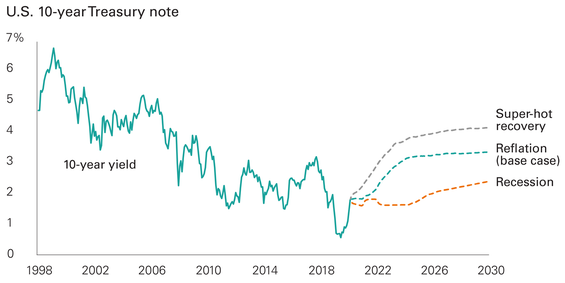Originally published on Vanguard.com.
By Alexis Gray, M.Sc. Vanguard Asia-Pacific senior economist
The COVID-19 pandemic made it abundantly clear that central banks had the tools, and were willing to use them, to counter a dramatic fall-off in global economic activity. That economies and financial markets were able to find their footing so quickly after a few downright scary months in 2020 was in no small part because of monetary policy that kept bond markets liquid and borrowing terms super-easy.
Now, as newly vaccinated individuals unleash their pent-up demand for goods and services on supplies that may initially struggle to keep up, questions naturally arise about resurgent inflation and interest rates, and what central banks will do next.
Vanguard's global chief economist, Joe Davis, recently wrote how the coming rises in inflation are unlikely to spiral out of control and can support a more promising environment for long-term portfolio returns. Similarly, in forthcoming research on the unwinding of loose monetary policy, we find that central bank policy rates and interest rates more broadly are likely to rise, but only modestly, in the next several years.
Prepare for policy rate lift-off … but not immediately

Notes: Lift-off date is the projected date of increase in the short-term policy interest rate target for each central bank from its current low. Rates for 2025 and 2030 are Vanguard projections for each central bank’s policy rate.
Source: Vanguard forecasts as of May 13, 2021.
Our view that lift-off from current low policy rates may occur in some cases only two years from now reflects, among other things, an only gradual recovery from the pandemic’s significant effect on labor markets. (My colleagues Andrew Patterson and Adam Schickling wrote recently about how prospects for inflation and labor market recovery will allow the U.S. Federal Reserve to be patient when considering when to raise its target for the benchmark federal funds rate.)
Alongside rises in policy rates, Vanguard expects central banks, in our base-case "reflation" scenario, to slow and eventually stop their purchases of government bonds, allowing the size of their balance sheets as a percentage of GDP to fall back toward pre-pandemic levels. This reversal in bond-purchase programs will likely put some upward pressure on yields.
We expect balance sheets to remain large relative to history, however, because of structural factors, such as a change in how central banks have conducted monetary policy since the 2008 global financial crisis and stricter capital and liquidity requirements on banks. Given these changes, we don't expect shrinking central bank balance sheets to place meaningful upward pressure on yields. Indeed, we expect higher policy rates and smaller central bank balance sheets to cause only a modest lift in yields. And we expect that, through the remainder of the 2020s, bond yields will be lower than they were before the global financial crisis.
Three scenarios for 10-year bond yields

We expect yields to rise more in the United States than in the United Kingdom or the euro area because of a greater expected reduction in the Fed's balance sheet compared with that of the Bank of England or the European Central Bank, and a Fed policy rate rising as high or higher than the others'.
Our base-case forecasts for 10-year government bond yields at decade’s end reflect monetary policy that we expect will have reached an equilibrium—policy that is neither accommodative nor restrictive. From there, we anticipate that central banks will use their tools to make borrowing terms easier or tighter as appropriate.
The transition from a low-yield to a moderately higher-yield environment can bring some initial pain through capital losses within a portfolio. But these losses can eventually be offset by a greater income stream as new bonds purchased at higher yields enter the portfolio. To any extent, we expect increases in bond yields in the several years ahead to be only modest.
I'd like to thank Vanguard economists Shaan Raithatha and Roxane Spitznagel for their invaluable contributions to this commentary.

